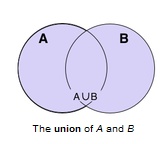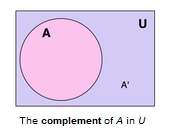Sets
A set contains elements.
Conversely, an element is a member of a set. The following phrases are
all used synonymously:
- x is a member of y
- x is contained in y
- x is included in y
- y contains x
- y includes x
The curly brace notation {
} is used to
denote members of a set. As an example, {1, 2, 3} denotes a
set
containing 1, 2, and 3 as members.
Empty or Null Set:
The set with no members is the empty or null set. The expressions
∅
{}
{x : x ≠ x}
all specify the empty set.
Special Sets:
Some sets are used frequently in mathematics so they are given by special
notation.
N = { Set of whole numbers} = {0, 1, 2, 3, 4, 5, ...}
Z = { Set of all integers} = {..., −5, −4, −3, −2, −1, 0, 1, 2, 3, 4, 5, ...}
N = { Set of rational numbers} = {a/b where a and b are integers and b ≠ 0}
R = { Set of real numbers}
Subsets:
A set S
is a subset of set A if every
member of S is a member of A.
We use the horseshoe notation to indicate subsets. The expression
{1, 2, 3} Í {1, 2, 3, 4}
says that {1, 2, 3} is a subset of {1, 2, 3, 4}. The empty set is a subset of every set. Every set is a subset of itself. A proper subset A is a subset of A that is not identical with A. The expression of
{1, 2, 3} Ì {1, 2, 3, 4}
says that {1, 2, 3} is a proper subset of {1, 2, 3, 4}.
Union:
Sets can be "added" together. The union of two sets A and B, denoted by A ∪ B, is the set of all things which are members of either A or B.

Some basic properties of unions are:
- A ∪ B = B ∪ A
- A Í A ∪ B
- A ∪ A = A
- A ∪ ∅ = A
- A Í B if and only if A ∪ B = B
Intersection:
A new set can also be constructed by determining which members two sets have "in
common". The intersection of A and B, denoted by
A ∩ B, is the set of all things which are members of both A
and B. If A ∩ B = ∅, then A and B are said
to be disjoint.

Some basic properties of intersections:

Some basic properties of intersections:
- A ∩ B = B ∩ A
- A ∩ B Í A
- A ∩ A = A
- A ∩ ∅ = ∅
- A Í B if and only if A ∩ B = A
Complements:
Sets may be "subtracted" from one another. The relative complement of A in
B, denoted by B \ A, (or B − A) is the set
of all elements which are members of B, but not members of A.
In certain settings all sets under discussion are considered to be subsets of a given universal set U. In such cases, U \ A, is called the absolute complement of A, and is denoted by A′.

In certain settings all sets under discussion are considered to be subsets of a given universal set U. In such cases, U \ A, is called the absolute complement of A, and is denoted by A′.

Some basic properties of complements:
-
- A ∪ A′ = U
- A ∩ A′ = ∅
- (A′ )′ = A
- A \ A = ∅
- A \ B = A ∩ B′


